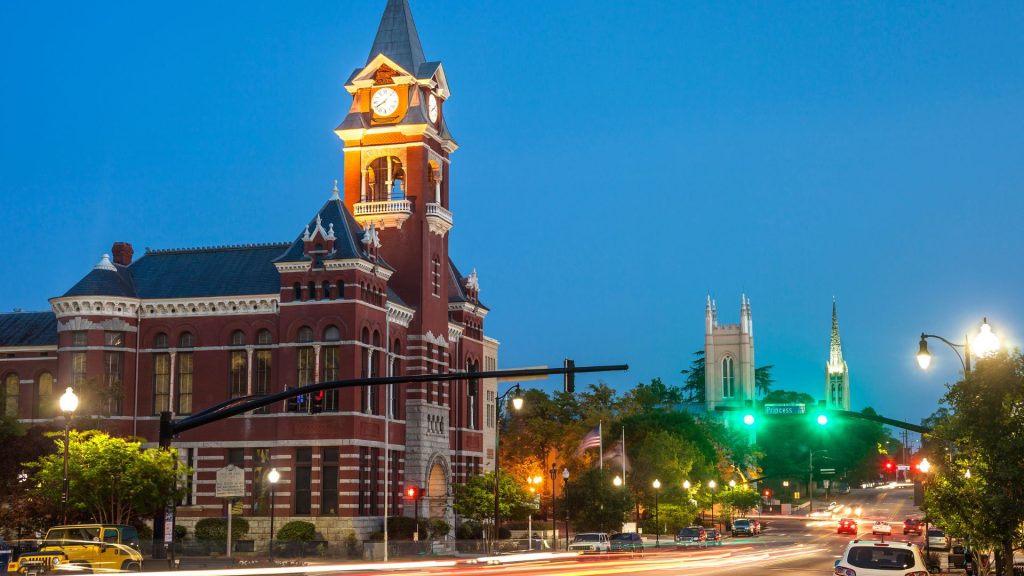The Allure of Historic Architecture in Wilmington’s Historic District
If you’re looking for a slice of history, Wilmington’s Historic District in North Carolina is a treasure trove of enchanting architecture that embodies the charm of a bygone era. This area showcases an impressive array of historic buildings, which reflect multiple architectural styles and narratives that captivate both residents and visitors alike.
The beautiful streets of Wilmington are lined with well-preserved 18th and 19th-century structures, creating a picturesque backdrop for leisurely strolls. You’ll find homes with intricate woodwork, elegant facades, and vibrant colors that have stood the test of time. Noteworthy architectural styles found in the district include:
- Federal: Characterized by simplicity and symmetry, the Federal style is notable for its rectangular shape, gabled roof, and often features a central entrance surrounded by elaborate trim. Examples include the Burgwin-Wright House.
- Greek Revival: Highlighted by its grand columns and pedimented roofs, these buildings evoke a sense of ancient elegance. The Bellamy Mansion is a fine example.
- Victorian: Spanning from 1837 to 1901, Victorian architecture showcases bold colors and ornate details. The Cameron Art Museum is set in an old Victorian-style building.
- Italianate: Emphasized by wide eaves and tall, narrow windows, the Italianate style offers a charming European flair. Look for the historic Thalian Hall.
As you explore this beloved district, you’ll discover that each block tells a story, echoing the vibrancy of Wilmington’s past. The intricate details on doorways and windows, the thoughtful landscaping, and the rich materials used in construction all contribute to the enchanting allure of the district.
Additionally, Wilmington’s Historic District is not just a feast for the eyes; it’s also a hub for culture and community. Here’s a brief look at some of the significant sites you won’t want to miss:
| Location | Description | Website |
|---|---|---|
| Burgwin-Wright House | This stunning structure offers a glimpse into Wilmington’s colonial past with its beautiful gardens and engaging tours. | Visit |
| Bellamy Mansion | A cultural icon, this mansion provides insights into 19th-century life, including its architectural significance and stories of its inhabitants. | Visit |
| Thalian Hall | An architectural gem and performing arts venue, recognized for both its history and continuing use for concerts and theaters. | Visit |
| Cameron Art Museum | Housed in a historic building, this art museum features rotating exhibits that celebrate both local and national art. | Visit |
Walking tours are an excellent way to soak in the beauty and history of the historic district. Many local guides share fascinating tales about the architecture and the people who lived in these remarkable homes. Whether you’re a local or a tourist, taking a stroll through Wilmington’s quaint streets feels like stepping back in time.
For those interested in events, the historic district often hosts festivals and gatherings that celebrate the culture and heritage of the area. Check out local calendars to catch a glimpse of what’s happening during your visit.
Furthermore, the preservation efforts in Wilmington’s Historic District ensure that future generations will be able to enjoy these remarkable architectural treasures. Engaging with local organizations devoted to conservation allows visitors to understand the importance of maintaining this picturesque area. It’s a vibrant community that thrives on its historical roots.
Your exploration of Wilmington wouldn’t be complete without appreciating the charm intertwined in every structure. The Historic District is not just a destination; it’s a living museum that invites you to linger, appreciate, and learn.
Exploring Wilmington’s Cultural Heritage Through Its Landmarks
Wilmington, North Carolina, is a city steeped in rich history and vibrant culture, showcasing an incredible array of landmarks that tell the story of its past. Exploring Wilmington’s cultural heritage is a rewarding experience, as it allows visitors to appreciate the architectural beauty and historical significance of its various sites. From grand antebellum homes to thriving arts districts, Wilmington serves as a window into the cultural lineage of the American South.
The Historic Architecture
One of the most captivating aspects of Wilmington is its well-preserved historic architecture. Walking through the streets of the Historic District immerses you in a world of beautiful buildings that date back to the 18th and 19th centuries. Visitors can marvel at the exquisite examples of Greek Revival, Victorian, and Colonial architecture. Some highlights include:
- The Bellamy Mansion: A quintessential antebellum mansion that showcases the architectural style and lifestyle of the late 19th century.
- The Burgwin-Wright House: Dating back to the 1770s, this is the oldest house museum in Wilmington, reflecting colonial history.
- Thalian Hall: A stunning theater built in 1858 that remains a center of performing arts and cultural events.
The Riverwalk Experience
The Wilmington Riverwalk runs along the Cape Fear River, offering stunning views and a perfect path for leisurely exploration. This revitalized area is adorned with shops, restaurants, and public art installations. Visitors can enjoy:
- Culinary Delights: Restaurants offer fresh seafood and southern comfort food, giving you a taste of local flavors.
- Public Art Displays: Open-air exhibitions showcase the work of local artists, providing cultural richness along the waterfront.
Museums that Speak Volumes
Wilmington hosts several museums that delve deep into its cultural history, allowing visitors to engage with the stories and artifacts that shape the city’s identity. Notable museums include:
- The Cape Fear Museum: This museum focuses on the region’s history and culture, featuring exhibits on local history, the environment, and the area’s role in the Civil War.
- The Cameron Art Museum: This cultural hotspot exhibits a mix of contemporary and historical art and offers a glimpse into the artistic evolution of the region.
- The Battleship North Carolina: An iconic World War II battleship that now serves as a museum, providing insight into military history and the sacrifices made.
Cultural Festivals and Events
Throughout the year, Wilmington hosts a variety of cultural festivals and events that celebrate its heritage. Attending these events offers additional insight into Wilmington’s local traditions. Key events include:
- The N.C. Azalea Festival: Celebrating spring with floral displays, concerts, and parades, this festival highlights the natural beauty of the region.
- Wilmington Riverfest: A maritime festival showcasing local crafts, music, and food against the backdrop of the Cape Fear River.
- The Wilmington Jewish Film Festival: This annual event brings together filmmakers and audiences to celebrate cultural diversity through cinema.
Educational Opportunities
For those keen on deepening their understanding of Wilmington’s heritage, several institutions provide educational programs and tours. Some options include:
- Guided Historical Tours: Local historians offer tours that weave together the stories behind the architecture and significant figures.
- Workshops and Classes: Engage in arts, crafts, or cooking classes at community centers or museums that mirror local traditions.
With its historic landmarks, vibrant arts scene, and engaging festivals, Wilmington continues to celebrate its unique cultural heritage. Whether you’re walking through the Historic District or enjoying a local festival, Wilmington’s charm is palpable. To fully grasp the city’s narratives, diving into its landmarks is an essential journey.
For more information on Wilmington’s cultural offerings, visit Wilmington and Beaches Convention & Visitors Bureau and Cameron Art Museum to plan your visit!
The Role of Wilmington Historic District in Local Tourism
The Wilmington Historic District serves as a vital hub in North Carolina’s local tourism landscape, attracting visitors from across the globe. With its enchanting blend of architectural styles, vibrant culture, and rich history, this charming area draws those eager to explore a place that feels both timeless and inviting.
One of the district’s main attractions is its diverse array of historic buildings. With over 230 blocks included in the National Register of Historic Places, visitors can experience a captivating journey through time. Here’s what makes it special:
- Architectural Variety: The district showcases a range of architectural styles, from Colonial Revival to Victorian and Italianate influences. This variety provides a visual feast that keeps photography enthusiasts engaged and eager to capture every detail.
- Rich History: The Wilmington Historic District played a significant role during the Civil War and in the development of the region. Museums and historical markers throughout the area offer insights into local events that shaped Wilmington.
- Quaint Streets: Walking through the cobblestone streets transports visitors to a different era. Each turn reveals charming shops, art galleries, and inviting cafes that reflect the character of the community.
Visitors often find it hard to resist the allure of the district’s various tours. These include:
| Tour Type | Description | Duration |
|---|---|---|
| Historical Walking Tours | Guided tours that delve into the area’s rich history and architectural highlights. | 2 – 3 hours |
| Ghost Tours | Spooky explorations of the district’s haunted spots, blending history with folklore. | 1.5 hours |
| Food Tours | Culinary adventures featuring local dishes and cuisines from various restaurants. | 3 hours |
Additionally, the Wilmington Historic District hosts various annual events that significantly contribute to local tourism. These events invite both residents and tourists, creating a lively community atmosphere. Some popular events include:
- Wilmington Riverfest: This annual festival features arts and crafts, live music, and a range of food vendors, celebrating the lively culture of the region.
- The North Carolina Azalea Festival: Celebrating the blooming of azaleas, this festival includes a parade, garden tours, and numerous community activities.
- Holiday Candlelight Tour: Visitors can stroll historic homes adorned for the holiday season, offering a magical glimpse into the district’s charm.
Moreover, the district plays a crucial role in supporting local businesses. The economic impact of tourism is substantial, as visitors frequent locally owned shops, dining establishments, and service providers. This has helped foster a sense of community and encourages the preservation of the area’s historical fabric.
Environmental initiatives within the Wilmington Historic District also attract eco-conscious travelers. The preservation of historic architecture alongside green spaces contributes to maintaining the district’s aesthetic while promoting sustainable tourism practices.
To explore the Wilmington Historic District and see its charm firsthand, various online resources provide comprehensive guides, tour bookings, and event information. For more details, check out Wilmington NC’s official tourism website and Wilmington’s Historical Society.
By engaging with both history lovers and casual tourists, the Wilmington Historic District fosters an environment where culture and community thrive. Its well-preserved architecture, vibrant events, and rich stories make it an attractive destination that keeps its visitors coming back year after year. This synergy between local tourism and the historic district contributes to Wilmington’s identity, making it a must-visit location in North Carolina.
Historical Narratives: Stories Behind Wilmington’s Historic Homes
Wilmington, North Carolina, is a treasure trove of history, and its historic homes stand as proud narratives of the past. Each residence tells a unique story that reflects the rich tapestry of the city’s culture and the lives of its inhabitants. From grand mansions to quaint bungalows, these homes are more than just structures; they are windows into the lives of those who shaped Wilmington.
The charm of Wilmington’s historic homes is defined not only by their architectural beauty but also by the events and people that entwined within their walls. Many of these homes date back to the 18th and 19th centuries, encapsulating styles ranging from Federal to Victorian. Below, we explore a few notable residences that exemplify the stories behind Wilmington’s historic fabric.
Bellamy Mansion
Constructed between 1859 and 1861, the Bellamy Mansion is an exquisite example of a Southern mansion with an intriguing past. Originally built for Dr. John D. Bellamy and his family, this home features Greek Revival and Italianate architectural styles. One fascinating tale is of the Bellamy family’s involvement in the American Civil War, which significantly impacted their socio-economic standing.
Thalian Hall
Thalian Hall isn’t just a theatre; it’s a historic landmark that has hosted performances and social gatherings since its opening in 1858. Famous personalities like Mark Twain have graced its stage. The Hall’s architecture, featuring neoclassical design, pairs with its vibrant history, making it an essential stop for understanding Wilmington’s cultural evolution.
The Burgwin-Wright House
The Burgwin-Wright House dates back to the late 18th century and provides an intimate glimpse into early American life. It served as both a residence and a tavern, hosting notable dignitaries of its time. The house is also reputedly haunted, adding a layer of intrigue to its historical narrative. Visitors enjoy exploring its preserved rooms that showcase period furnishings and artifacts.
The Latimer House
Originally built in 1852, the Latimer House is another gem highlighting Wilmington’s historic charm. The house features a blend of Greek Revival and Italianate styles and offers insights into the life of its original owner, William Latimer. The home serves not only as a museum but also as a testament to Wilmington’s vibrant historical community.
Historic District Walking Tours
For those looking to absorb the stories of these landmarks, the historic district offers walking tours that highlight many of these homes. Guides share captivating tales, including:
- Architectural features that reflect the period styles.
- Personal anecdotes related to prominent families.
- Historical events that took place in or around these houses.
These tours provide an engaging way to experience Wilmington’s history firsthand while walking down the cobblestone streets that have endured centuries of stories.
Interesting Facts Table
| Home | Year Built | Architectural Style | Interesting Fact |
|---|---|---|---|
| Bellamy Mansion | 1859-1861 | Greek Revival, Italianate | Served as a Confederate donator during the Civil War. |
| Thalian Hall | 1858 | Neoclassical | Home to one of the oldest continuously operating theatres in North Carolina. |
| Burgwin-Wright House | 1770 | Georgian | Reputedly haunted by former owners. |
| Latimer House | 1852 | Greek Revival, Italianate | Original owner William Latimer was a significant local figure. |
Exploring Wilmington’s historic homes is more than a mere visit; it’s an immersion into narratives that shaped the community. The charm of these homes lies in their ability to whisper the tales of yesteryear, making each story a timeless piece of Wilmington’s legacy. Whether you’re a history buff or a casual visitor, the enchanting tales behind Wilmington’s historic homes promise to captivate your imagination.
For a deeper dive into Wilmington’s history, consider visiting the Wilmington Historical Society or planning to attend one of their events that celebrate this vibrant heritage.
Culinary Delights: Dining in the Heart of Wilmington’s Historic District
Wilmington’s Historic District is not only a treasure trove of history and architecture, but it also boasts an impressive array of dining options that reflect the region’s rich culinary scene. Nestled along the scenic Cape Fear River, this vibrant community offers a delightful mix of flavors, making it an ideal destination for food enthusiasts. From seafood to Southern comfort food, the culinary landscape of the Historic District beckons visitors to sample a taste of local culture.
One can’t discuss dining in Wilmington without mentioning the abundance of fresh seafood. The proximity to the ocean ensures that diners enjoy some of the freshest catches available. A must-visit spot is Wilmington Fish Market, where you can dive into dishes like shrimp and grits or crab cakes that are sure to delight. The casual, welcoming atmosphere adds to the charm, allowing guests to savor their meals while soaking in the historic surroundings.
Another standout establishment is Masonboro Grill. Here, the menu pays homage to classic Southern cuisine, offering everything from fried green tomatoes to slow-cooked pulled pork sandwiches. The restaurant prides itself on using locally sourced ingredients, which not only enhances the flavors but also supports nearby farmers and businesses. Enjoying a meal on the patio is a great way to immerse yourself in the ambiance of Wilmington’s Historic District.
For those seeking a more upscale dining experience, Cotton Room is a stylish choice highlighted by its creative menu featuring Southern-inspired dishes with a modern twist. Don’t miss their signature dishes like the pecan-crusted chicken or the shrimp and scallops served over a bed of seasonal vegetables. The restaurant boasts an extensive wine list, making it a perfect place for special occasions or a romantic dinner.
Vegetarians and health-conscious diners will find a selection of delightful options as well. The Greenhouse serves fresh, farm-to-table meals with plenty of choices that showcase seasonal vegetables and innovative recipes. Their hearty salads and unique grain bowls are both satisfying and nourishing, reflecting the diverse culinary talents that can be found in the district.
When it comes to dessert, few places rival The Ice Cream Parlor. This family-owned establishment is beloved for its homemade ice creams and traditional sundaes. With flavors ranging from classic vanilla to unique concoctions like lavender-infused honey, it’s a popular stop for visitors and locals alike. A scoop of their rich ice cream is the perfect way to end a delectable day in Wilmington.
| Restaurant | Cuisine Type | Signature Dish | Website |
|---|---|---|---|
| Wilmington Fish Market | Seafood | Shrimp and Grits | Visit |
| Masonboro Grill | Southern | Fried Green Tomatoes | Visit |
| Cotton Room | Upscale Southern | Pecan-Crusted Chicken | Visit |
| The Greenhouse | Vegetarian | Grain Bowls | Visit |
| The Ice Cream Parlor | Dessert | Lavender-Infused Ice Cream | Visit |
As the day winds down, exploring the nightlife options can lead to some additional culinary discoveries. Many bars and eateries offer live music alongside delicious appetizers and cocktails. Places like The Blind Elephant serve up craft cocktails that pair beautifully with their small plates, providing a laid-back experience for those looking to unwind after a day of exploration.
Ultimately, dining in the heart of Wilmington’s Historic District transcends mere nourishment; it’s an experience steeped in the character of the region. From seafood shanties to elegant bistros, every meal tells a story, inviting you to connect with the history and culture that define this charming destination. Don’t miss out on the opportunity to savor the flavors that make Wilmington truly unique. Plan your visit and take advantage of the eclectic gastronomic offerings that await you.
Conclusion
Wilmington’s Historic District weaves a captivating tapestry of culture, architecture, and culinary experiences that is unlike any other in North Carolina. As you stroll through the tree-lined streets, the allure of historic architecture beckons from every corner. Each building, from majestic antebellum homes to charming Victorian structures, tells a story of the past, providing visitors with a glimpse into a rich architectural heritage. The intricate details and striking facades of these structures underscore the effort taken by the residents and preservationists to maintain Wilmington’s unique character, making each visit an educational experience.
Exploration of Wilmington’s cultural heritage takes center stage in this Historic District, where landmarks serve as a bridge connecting the past to the present. Sites such as the Bellamy Mansion and the Burgwin-Wright House not only stand as beautiful relics of history but also offer insights into the lives of their former residents. These historic homes are more than mere attractions; they serve as repositories of local lore and heritage, enabling visitors to appreciate the intricate narratives that shaped the very fabric of the city. This engrossing fusion of education and exploration invites travelers of all backgrounds to engage with history in a tangible way.
Tourism thrives in Wilmington’s Historic District, driven by the allure of its rich history and vibrant culture. Antique shops, art galleries, and local boutiques line the streets, each offering unique finds and experiences. Visitors flock to the area not only to soak in the visuals of the charming architecture but also to partake in community events that celebrate the culture of Wilmington. The accessibility of the Historic District makes it an attractive destination for tourists and locals alike, while the careful balance of preservation and modernity ensures that the area remains relevant in today’s context. It’s this synergy that fosters a communal spirit, inviting people to become part of Wilmington’s ongoing narrative.
Delving into the historical narratives that accompany Wilmington’s historic homes enhances the overall experience of the district. Each property has its own story—be it tales of former residents, architectural styles, or significant events that unfolded within the walls. These narratives enrich the visitor experience, allowing individuals to appreciate the area from a more personal lens. Walking tours often provide local insights that reveal lesser-known facts, essentially bringing the history to life. Thus, visitors can leave with tangible connections to the past, deepening their appreciation and understanding of what Wilmington has to offer.
Culinary experiences abound, transforming Wilmington’s Historic District into a delightful destination for food enthusiasts. The area is not just about history; it boasts a burgeoning food scene rife with local flavors. From quaint cafés to upscale dining, the district provides a culinary journey reflecting local ingredients and culinary traditions. Restaurants often source their menu items from nearby farms, ensuring that each dish is fresh and unique. Visitors can indulge in Southern comforts, or sample innovative takes on traditional dishes, adding a flavorful twist to their exploration of Wilmington’s history.
Wilmington’s Historic District stands as a multifaceted gem with something for everyone. It embraces the past while celebrating the present, with each visit offering new discoveries. Whether you’re captivated by the historical architecture, eager to absorb tales of the past, or ready to savor culinary delights, the district promises an experience that is both enriching and enjoyable. In exploring Wilmington’s rich cultural heritage, tourists and locals alike become part of a vibrant living history, contributing their own stories and experiences to the ongoing dialogue of this lovely area.
As you plan your next adventure, make sure to include Wilmington’s Historic District on your itinerary. Immerse yourself in its charm, explore its landmarks, and savor its culinary delights. With so much to discover around every corner, you’ll find that Wilmington is not just a destination, but a remarkable journey through time that invites every visitor to create memories that last a lifetime.







